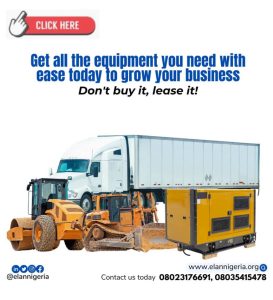
Leasing is the creative financing alternative of today because it meets diverse needs. A lease is an agreement whereby the lessor (owner of equipment) convey to the lessee (user of equipment) the right to use the asset for an agreed period of time, in return for a payment or series of payments.
Below are the reasons why this is so
- Alternative source of capital financing: Leasing provides an alternate source of financing where a company is faced with tight credit terms, bank lending restrictions or other economic factors. It is a prudent means of equipment acquisition. It releases credit lines that can be used for other purposes, ie. It allows for full use of borrowing capacity.
- Affordable means of acquiring equipment: Leasing provides an affordable avenue for lessees (user of equipment) to acquire the much needed asset with minimal initial payment. This is because payment constitutes very small fraction of the equipment cost, which is spread over the lease period.
- Flexibility in lease rental payment: Lease payment can be made to coincide with earnings generated from the use of the equipment. This is particularly advantages in a situation where companies have seasonal income.
- Longer payment terms than other forms of credit: Leasing affords the lessee the opportunity of payment over a longer period than with most other forms of financing. This allows the lessee the opportunity of reducing financial commitments particularly in times of distress.
- Easy accessibility of equipment: Lease facilities are often easier to obtain than loans. Equipment under lease, while providing facility for use, also serves as collateral for the lease since ownership actually resides with the lessor (owner of equipment). Hence, in the event of a failure on the part of the lessee to pay, the equipment can be retrieved by the lessor.
- Budget limitations: Acquisition of equipment not complemented by capital expenditure budget can sometimes be accomplished through lease with rental payments classified as operating expenses.
- Technology considerations: When firms purchase equipment, they face the possibility that at some time the asset may not be efficient as recently manufactured ones. The lessor may elect to obtain the new version for the lessee, if the latter desires.
- Collateral: There is usually no need for additional security or collateral for a lease. Generally, the equipment serves as security.
- Risk of leakage: There is reduced risk of leakage in equipment leasing transaction, since the lessee does not receive cash. The lessor purchase and supplies the equipment thus reducing the diversion of funds.
Reasons to Choose Equipment Leasing over a Loan
In a world of ever-decreasing human interaction, why would someone seek the help of an unfamiliar leasing company when their local banker calls them by name? We will tell you why:
- The first major difference between a lease and a loan is collateral. A loan will automatically require a collateral before it can be granted, leases does not require any form of collateral, because the leased asset will stand as the collateral, making leases the easiest and most convenient means of asset acquisition you can get.
- Leasing provides additional source of credit to the customer asides the traditional financing methods. Leasing does not limit the capacity of the customer to borrow unlike loan that most cases have restrictive covenants
- Leases are in terms of time and costs involved in negotiating terms and conditions of each financing alternatives.
- Leasing is highly flexible, than loans in terms of rental payments . Essentially, leases can be packaged in various forms to meet the cash flow and circumstances of the customer. Rentals can be even, skipped or step up or step down not readily available in loans
- Lease rentals are generally fixed outflows unlike loans that have interest rates that change with market conditions.
- Leases give the customer options to either return, renew, or purchase the asset at the end of the lease unlike loans
Equipment leasing advantages:
A lease facility is generally easier to package, and takes fewer days to deliver, with few financials or paperwork requirements. Leasing transactions can be packaged to include delivery, installation, training, hardware and software and services etc.
Another interesting area in leasing is the rental payment. Rentals can be structured to meet the cash flow of the lessee, which can be done monthly, bi-monthly, quarterly, half yearly or otherwise. For instance, a school proprietor that acquire a school bus or power generating sets through leasing may decide to be paying rentals only during the school session while no payment is done during the holidays period. This gives greater flexibility as well as renewed focus on its core business.
This important choice of asset acquisition model should be based on your business’ requirements and circumstances. With ELAN we help you take the time to get to know you and understand your business goals and objectives, and recommend Lease Practitioners with workable lease solutions, geared towards meeting your business goals and objectives.
How Does Equipment Leasing Work?
Basically, leasing involves productive assets owned by one person (the lessor) but used by another person (the lessee) in return for periodic rentals, resulting in convenient and predictable cash flows for the lessee.
Equipment Leasing services are being provided by leasing companies. A Lessee (user of asset) approaches a Lessor (owner of asset) for a lease facility, stating the equipment needed and the purposes it is expected to serve. The lease is approved after meeting the requirements of the Lessor, the asset is delivered and the transaction commences. Due to the installment payments in a lease, the lessee is able to obtain the use of an asset without tying up scarce funds needed to acquire the asset.
For instance, a small construction company needs to purchase a bulldozer for expansion purposes. The firm rather than tying the huge sum of money on this single asset and become cash-strapped, the firm may go for leasing. Accessing this equipment through leasing, releases its funds for other productive ventures such as working capital. The firm is now enjoying the benefits of this new equipment while paying the rentals over time.
Basically, there are 2 types of leasing: Finance and Operating Leases. Under finance leases, the lessee uses the asset while paying rentals. The intention of the lessee is to own the asset at the end of the transaction, while under operating leases, the lessee uses the asset and later returns it to the lessor.
In other to further assist your search for a credible leasing service provider, The Equipment Leasing Association of Nigeria (ELAN) can guide prospective lessees to credible lessors faster.
What to Look for in a Leasing Service Provider?
Now that you understand a little bit about lease financing, you will need to know what to look for in a leasing service provider. Financing, leasing and loans can be a tricky business.
The important qualities to note are knowledge, integrity and reputation, diversity of product, flexibility and responsiveness along with industry ratings. A leasing company with the ability to lease assets with high level of understanding of the lessees’ needs is important when selecting a leasing company.
Leasing makes better sense, DON’T BUY IT, LEASE IT…
Need to know more on how equipment leasing can be useful to you and how you can get paid from leveraging it? visit www.elannigeria.org to download our resources and follow our social media pages for more updates. You can also speak to leasing expert or contact us info@elannigeria.org, 08035415478, 08023176691.

